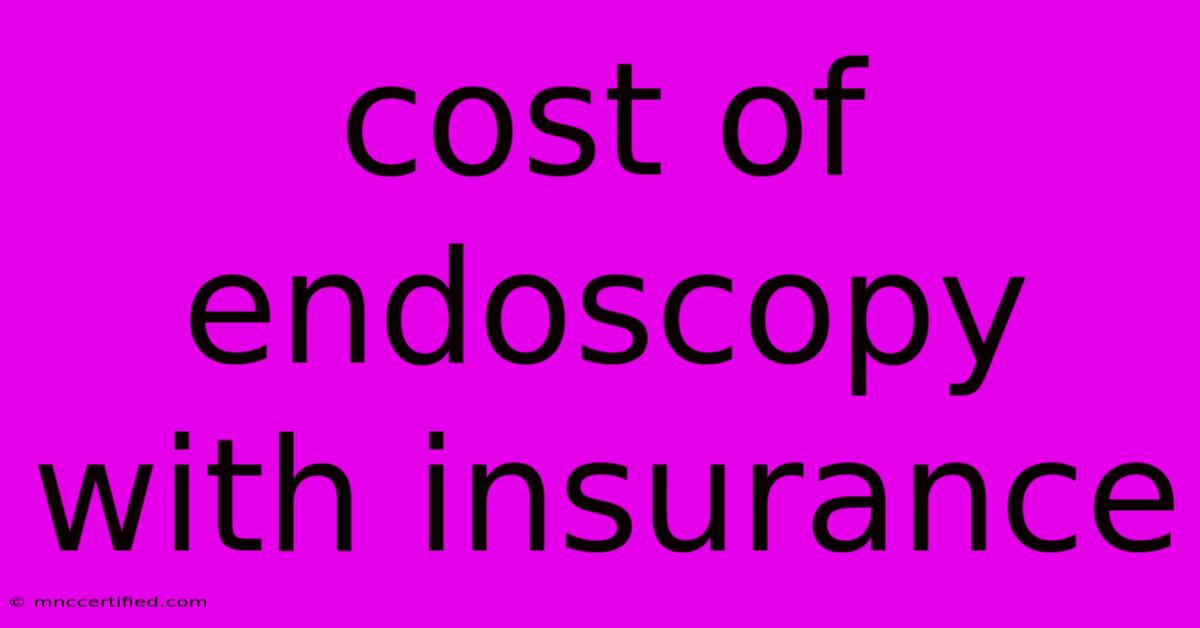Cost Of Endoscopy With Insurance

Table of Contents
The Cost of Endoscopy with Insurance: A Comprehensive Guide
Understanding the cost of a medical procedure like an endoscopy can be daunting, especially when insurance is involved. This comprehensive guide breaks down the potential expenses, how insurance impacts the final bill, and steps you can take to navigate the process effectively. We'll cover various types of endoscopy, factors affecting cost, and ways to minimize your out-of-pocket expenses.
What is an Endoscopy and its Different Types?
An endoscopy is a minimally invasive medical procedure used to examine the internal organs of the body. A thin, flexible tube with a camera (endoscope) is inserted into the body through a natural opening, allowing doctors to visualize and diagnose various conditions. The type of endoscopy performed depends on the area being examined:
-
Upper Endoscopy (Esophagogastroduodenoscopy or EGD): Examines the esophagus, stomach, and duodenum (the first part of the small intestine). This is commonly used to diagnose ulcers, inflammation, and cancers.
-
Colonoscopy: Examines the large intestine (colon) and rectum. It's crucial for colorectal cancer screening and diagnosing other bowel conditions like polyps and inflammatory bowel disease (IBD).
-
Sigmoidoscopy: A shorter procedure that examines only the lower part of the large intestine (sigmoid colon and rectum).
-
Capsule Endoscopy: Uses a small, disposable camera pill swallowed by the patient. Images are transmitted wirelessly as it travels through the digestive tract. Primarily used for small bowel examination.
Factors Affecting the Cost of Endoscopy with Insurance
The cost of an endoscopy with insurance varies significantly depending on several factors:
-
Type of Endoscopy: As mentioned above, different procedures have different costs due to varying levels of complexity and time involved. Colonoscopies, for example, typically take longer and may be more expensive than sigmoidoscopies.
-
Medical Necessity: Insurance companies typically cover medically necessary procedures. If the endoscopy is deemed necessary by your doctor based on symptoms or screening guidelines, the likelihood of coverage is higher. Elective procedures may have limited coverage.
-
Location: The geographic location of the facility performing the endoscopy plays a role in pricing. Costs tend to vary between different states and even within the same city.
-
Anesthesia: Most endoscopies require sedation or anesthesia, adding to the overall cost. The type and duration of anesthesia will also influence the final price.
-
Complications: Any unexpected complications during or after the procedure will likely increase the total cost.
-
Insurance Plan: Your specific insurance plan significantly impacts your out-of-pocket expenses. Factors such as your deductible, copay, coinsurance, and out-of-pocket maximum all affect the amount you will pay. Understanding your plan's coverage for endoscopy is crucial. Check your policy documents or contact your insurance provider.
What to Expect from Your Insurance Company
Most insurance plans cover endoscopies deemed medically necessary. However, the extent of coverage varies widely depending on your plan:
-
Deductible: You'll likely have to meet your annual deductible before your insurance starts covering the procedure.
-
Copay: This is a fixed amount you pay each time you receive a covered service.
-
Coinsurance: This is the percentage of the cost you pay after meeting your deductible.
-
Out-of-Pocket Maximum: This is the most you'll pay out-of-pocket for covered services in a plan year. Once you reach this limit, your insurance typically covers 100% of the remaining costs.
-
Network Providers: Using in-network providers (doctors and facilities contracted with your insurance company) usually results in lower out-of-pocket costs.
Minimizing Your Out-of-Pocket Costs
To minimize your expenses:
-
Check your insurance coverage: Before scheduling the procedure, contact your insurance provider to understand your specific coverage, including deductibles, copays, and coinsurance.
-
Use in-network providers: This often significantly reduces your expenses.
-
Ask about payment plans: Some healthcare facilities offer payment plans to make the procedure more affordable.
-
Negotiate costs: While not always possible, you can try to negotiate the cost of the procedure with the facility or doctor's office.
-
Explore financial assistance programs: Some hospitals and healthcare systems offer financial assistance programs for patients who are unable to afford their medical bills.
Conclusion: Planning Ahead is Key
The cost of an endoscopy with insurance is a complex issue. By understanding the factors that influence the cost, your insurance coverage, and available resources for financial assistance, you can better prepare for this important medical procedure and minimize your financial burden. Always communicate openly with your doctor and insurance provider to ensure a smooth and financially manageable experience.

Thank you for visiting our website wich cover about Cost Of Endoscopy With Insurance. We hope the information provided has been useful to you. Feel free to contact us if you have any questions or need further assistance. See you next time and dont miss to bookmark.
Featured Posts
-
Dental Arts Of Hoboken Insurance
Nov 21, 2024
-
Fortnite Update 32 11 Server Downtime
Nov 21, 2024
-
Geres Live Tv Incident With Guthrie
Nov 21, 2024
-
Iso 20022 Coins Price Prediction
Nov 21, 2024
-
Car Insurance Quotes Valdosta Ga
Nov 21, 2024